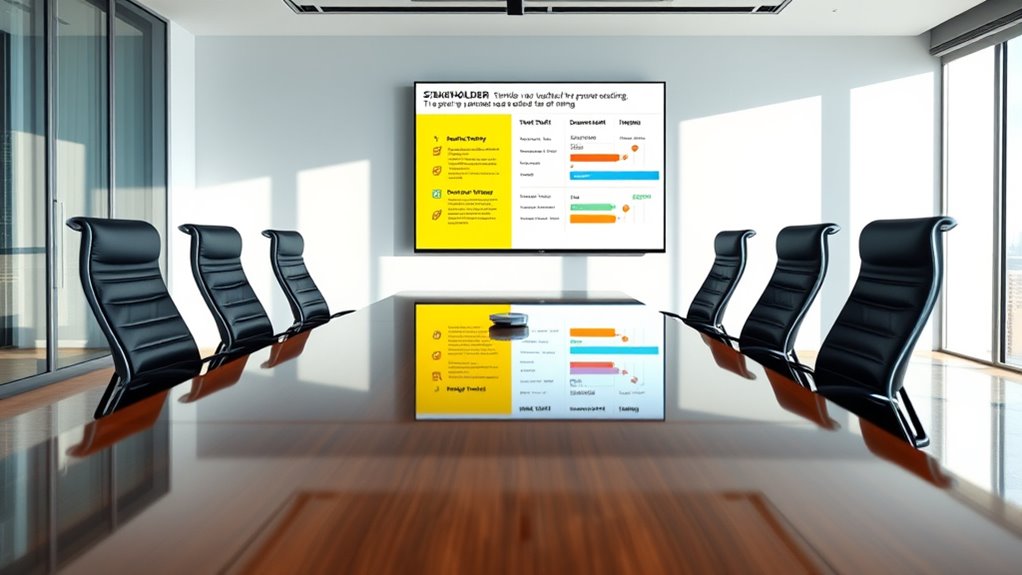To effectively manage stakeholder updates, develop clear templates that focus on concise, relevant information, and tailor your messaging channels to suit your audience. Schedule updates consistently—weekly or bi-weekly for ongoing projects, monthly or quarterly for slower developments—and adjust frequency based on project pace and stakeholder feedback. Striking the right balance keeps your stakeholders engaged and informed. If you want to learn more about optimizing your update timing and templates, keep exploring these strategies.
Key Takeaways
- Establish a regular update schedule (weekly, monthly, quarterly) aligned with project pace and stakeholder needs.
- Use clear, concise templates that highlight key information and progress to ensure effective communication.
- Adjust update frequency based on project developments and stakeholder feedback to maintain engagement without overwhelm.
- Utilize diverse channels (emails, dashboards, meetings) to deliver timely updates tailored to stakeholder preferences.
- Focus on high-quality, relevant content to foster trust, transparency, and stakeholder confidence in project progress.

Have you ever wondered how organizations keep their stakeholders informed and engaged? The key lies in effective communication strategies that are tailored to your audience’s needs and expectations. One of the most critical components of those strategies is determining the right update frequency. Too frequent, and stakeholders may feel overwhelmed or disengaged; too infrequent, and they might feel disconnected or out of the loop. Striking the right balance ensures your communication remains relevant, timely, and impactful.
Your communication strategies should outline clear guidelines on how often updates are sent out. For some projects, weekly or bi-weekly updates work best, providing a steady flow of information that keeps stakeholders aligned with ongoing progress. For others, monthly or quarterly updates may be sufficient, especially if the project evolves slowly or involves sensitive information requiring more careful dissemination. The goal is consistency—you want stakeholders to come to expect updates at reliable intervals, which builds trust and reinforces transparency.
Choosing the right update frequency also depends on the nature of the information being shared. If there are rapid developments, such as project milestones or critical changes, more frequent updates help manage expectations and prevent misinformation. Conversely, routine updates that highlight steady progress or upcoming tasks can be scheduled less often. Remember, the quality of your updates matters more than their quantity. Clear, concise, and relevant information is what keeps stakeholders engaged and reassures them that their investment of time and resources is yielding results.
Your communication strategies should also include a plan for adjusting update frequency as circumstances change. Flexibility is essential; if you notice stakeholders becoming disengaged or overwhelmed, consider revising your schedule. Regular feedback from your audience can guide these adjustments, ensuring your updates remain valuable and well-received. Incorporating diverse channels—such as emails, dashboards, meetings—and understanding the expiration of content can also help tailor the timing and format of your updates to maximize engagement.
Ultimately, the success of your stakeholder updates hinges on consistent timing and thoughtful messaging. By establishing and adhering to a well-planned update frequency aligned with your communication strategies, you foster stronger relationships built on trust and transparency. Remember, the goal isn’t just to inform but to keep stakeholders actively engaged and confident that they’re part of a well-managed process. When your updates arrive at the right intervals, with meaningful content, you strengthen stakeholder confidence and support the overall success of your initiatives.
Frequently Asked Questions
How Do I Personalize Stakeholder Update Templates Effectively?
To personalize stakeholder update templates effectively, focus on customization strategies that resonate with your audience. Use template customization by including their names, specific interests, and relevant updates. Tailor content to address their priorities and concerns, making updates more engaging. Incorporate visuals or data relevant to each stakeholder’s role. This approach shows you value their engagement, fostering stronger relationships and ensuring your updates are both meaningful and impactful.
What Are the Best Tools for Scheduling Stakeholder Updates?
Think of scheduling stakeholder updates as orchestrating a symphony, where timing and communication flow harmoniously. You’ll want tools like Microsoft Outlook, Google Calendar, or project management platforms like Asana or Trello to keep the rhythm steady. These tools help you stay on beat with stakeholder engagement, ensuring your updates happen at just the right moments. Regular communication frequency builds trust, making your updates feel like a well-rehearsed performance everyone enthusiastically anticipates.
How Can I Measure the Impact of Stakeholder Updates?
You can measure the impact of stakeholder updates by analyzing engagement metrics like open rates, click-through rates, and attendance. Incorporate feedback loops by soliciting direct responses or surveys to gauge understanding and satisfaction. Tracking changes over time helps you see if updates are influencing decision-making or collaboration. Combining engagement metrics with feedback loops offers a thorough view of how effective your updates are and where improvements are needed.
What Are Common Mistakes to Avoid in Stakeholder Communication?
You should avoid common communication pitfalls like overloading stakeholders with information or using jargon that hampers understanding. Keep your stakeholder engagement clear and concise, focusing on relevant updates. Don’t neglect timely communication, which can lead to disengagement. Also, avoid inconsistent messaging, as it erodes trust. Remember, effective communication is about fostering transparency and trust, so tailor your updates to meet stakeholder needs and expectations, steering clear of these pitfalls.
When Is the Optimal Time to Send Stakeholder Updates?
You should send stakeholder updates during key milestones or when significant progress occurs, ensuring timely communication. Using timing strategies like regular update frequency helps maintain transparency and trust. Avoid waiting too long, which can cause uncertainty, or sending updates too frequently, which may overwhelm stakeholders. Aim for a consistent schedule, such as weekly or bi-weekly, tailored to project pace and stakeholder needs, to keep everyone informed and engaged effectively.
Conclusion
Now that you understand the importance of timely, well-structured stakeholder updates, you’re ready to refine your approach. But remember, the true impact lies in how you deliver these messages—every detail counts. Will your next update inspire confidence or cause doubt? The choice is yours, and the clock is ticking. Stay prepared, stay strategic, and keep your stakeholders engaged. The next update could be the turning point—are you ready to make it count?









